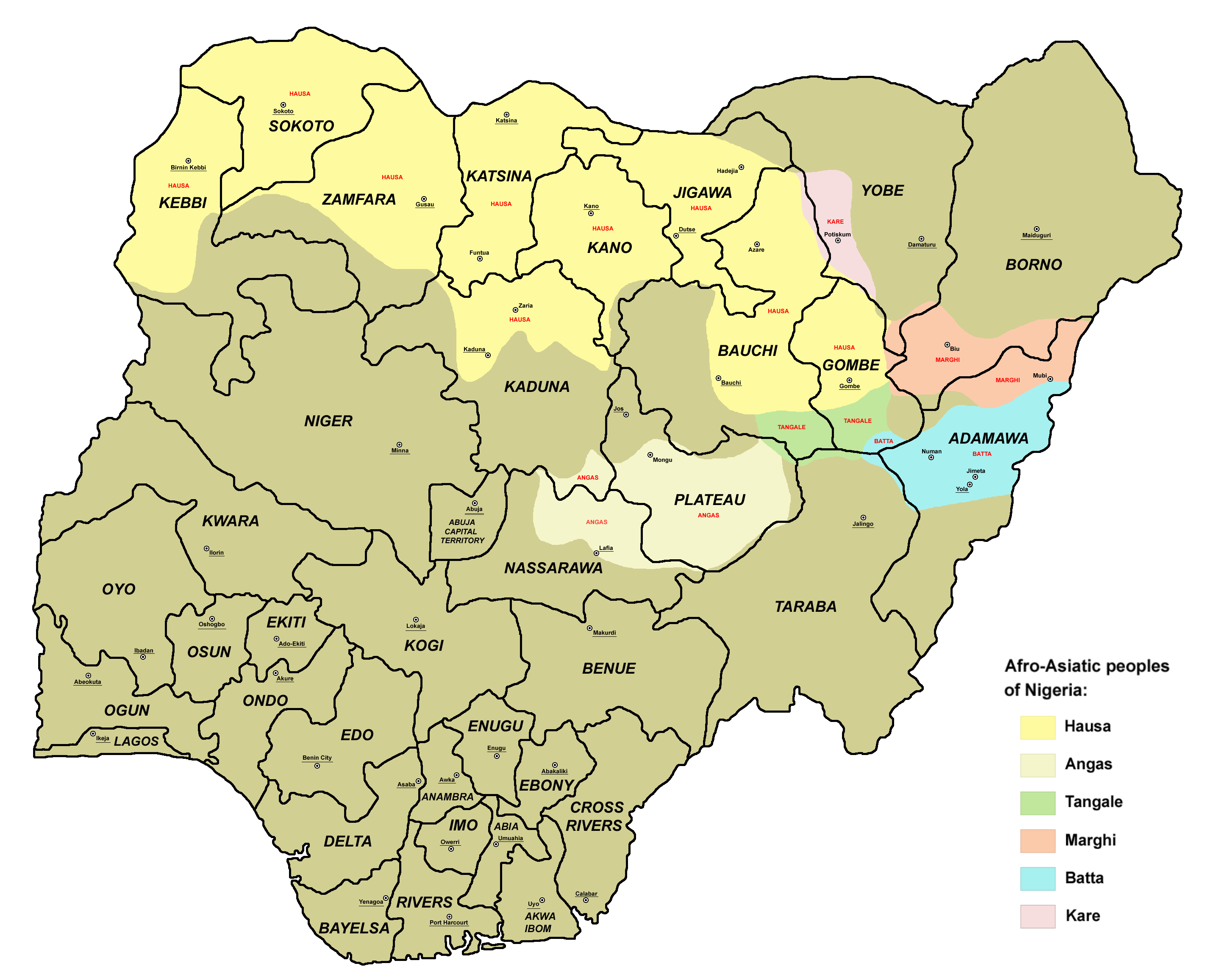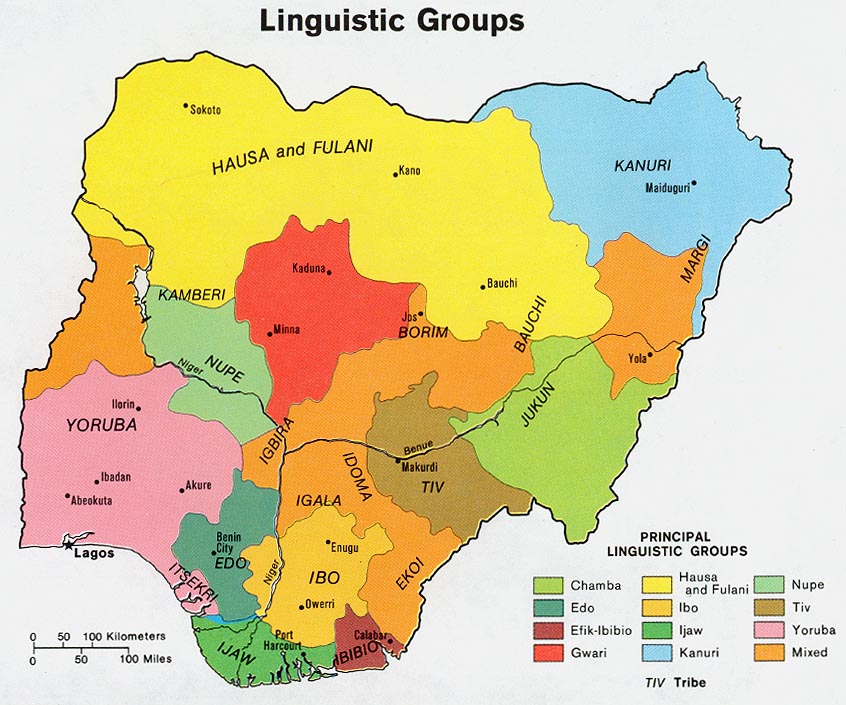|
Chadic
The Chadic languages form a branch of the Afroasiatic language family. They are spoken in parts of the Sahel. They include 196 languages spoken across northern Nigeria, southern Niger, southern Chad, and northern Cameroon. By far the most widely spoken Chadic language is Hausa, a lingua franca of much of inland Eastern West Africa, particularly Niger and the northern half of Nigeria. Hausa is the only Chadic language with more than 1 million speakers. Composition Paul Newman (1977) classified the languages into the four groups which have been accepted in all subsequent literature. Further subbranching, however, has not been as robust; Roger Blench (2006), for example, only accepts the A/B bifurcation of East Chadic. Subsequent work by Joseph Lovestrand argues strongly that Kujarge is a valid member of East Chadic. The placing of Luri as a primary split of West Chadic is erroneous. Bernard Caron (2004) shows that this language is South Bauchi and part of the Polci cluster. A sugge ... [...More Info...] [...Related Items...] OR: [Wikipedia] [Google] [Baidu] |
Afroasiatic Languages
The Afroasiatic languages (also known as Afro-Asiatic, Afrasian, Hamito-Semitic, or Semito-Hamitic) are a language family (or "phylum") of about 400 languages spoken predominantly in West Asia, North Africa, the Horn of Africa, and parts of the Sahara and Sahel. Over 500 million people are native speakers of an Afroasiatic language, constituting the fourth-largest language family after Indo-European, Sino-Tibetan, and Niger–Congo. Most linguists divide the family into six branches: Berber (Amazigh), Chadic, Cushitic, Egyptian, Omotic, and Semitic. The vast majority of Afroasiatic languages are considered indigenous to the African continent, including all those not belonging to the Semitic branch (which originated in West Asia). The five most spoken languages are; Arabic (of all varieties) which is by far the most widely spoken within the family, with around 411 million native speakers concentrated primarily in West Asia and North Africa, the Chadic Hausa language w ... [...More Info...] [...Related Items...] OR: [Wikipedia] [Google] [Baidu] |
West Chadic Languages
The West Chadic languages of the Afroasiatic languages, Afro-Asiatic family are spoken principally in Niger and Nigeria. They include Hausa language, Hausa, the most populous Chadic languages, Chadic language and a major language of West Africa. Languages The branches of West Chadic go either by names or by letters and numbers in an outline format. *West Chadic **Hausa–Gwandara languages, Hausa–Gwandara (A.1): Hausa language, Hausa, Gwandara language, Gwandara **Bole–Angas (?) ***Bole–Tangale languages, Bole–Tangale (A.2) ****North (Bole proper): Bure language, Bure, Karekare language, Karekare, Bole language, Bole, Gera language, Gera, Geruma language, Geruma, Deno language, Deno, Galambu language, Galambu, Giiwo language, Giiwo, Kubi language, Kubi, Ngamo language, Ngamo, Maaka language, Maaka (Maagha), Ɓeele language, Ɓeele, Dazawa language, Daza (Dazawa), ?Pali language (Chadic), Pali ****South (Tangale): Kwaami language, Kwaami, Pero language, Pero, Piya-Kw ... [...More Info...] [...Related Items...] OR: [Wikipedia] [Google] [Baidu] |
Angas Languages
The Angas, Angas–Sura, or Central West Chadic languages (also known as A.3 West Chadic) are a branch of West Chadic languages spoken in Plateau State, north-central Nigeria. Languages The Angas languages are:Blench, Roger. 2017Current research on the A3 West Chadic languages ;Angas *Ngasic: Ngas (Angas), Belnəng; ? Miler *Mwaghavulic: Mwaghavul, Mupun (Mapun), Takas (Toos); Cakfem-Mushere * Miship (Chip) *Pan cluster ** Chakato; Jorto (spurious) ** Jipal, Mernyang (Mirriam), Kwagallak, Kofyar (Doemak), Bwol, Goram, Jibyal * Nteng *Tel (Tɛɛl, Montol) *Talic: Tal, Pyapun, Koenoem *Goemaic: Goemai * Yiwom (Ywom, Gerka) Note that in the language names, orthographic '' oe'' stands for the mid central vowel ə, a practice that had been adopted by missionaries in the Shendam area during the 1930s, such as Father E. Sirlinger. Unlike many other West Chadic languages, Angas languages do not have complex nominal and verbal morphology. Ywom is the most divergent language ... [...More Info...] [...Related Items...] OR: [Wikipedia] [Google] [Baidu] |
Proto-Afroasiatic Language
Proto-Afroasiatic (PAA), also known as Proto-Hamito-Semitic, Proto-Semito-Hamitic, and Proto-Afrasian, is the reconstructed proto-language from which all modern Afroasiatic languages are descended. Though estimations vary widely, it is believed by scholars to have been spoken as a single language around 12,000 to 18,000 years ago (12 to 18 kya), that is, between 16,000 and 10,000 BC. Although no consensus exists as to the location of the Afroasiatic homeland, the putative homeland of Proto-Afroasiatic speakers, the majority of scholars agree that it was located within a region of West Asia or Northeast Africa. The reconstruction of Proto-Afroasiatic is problematic and has not progressed to the degree found in Indo-European linguistics. The immense amount of time over which the branches have been separated, coupled with the wide gap between the attestations of the original branches (3rd millennium BC for Egyptian language in Northeast Africa and Semitic languages in Weste ... [...More Info...] [...Related Items...] OR: [Wikipedia] [Google] [Baidu] |
East Chadic Languages
The three dozen East Chadic languages of the Chadic family are spoken in Chad and Cameroon. Speakers of various East Chadic languages are locally known as Hadjarai peoples. The largest East Chadic language is Nancere. Languages The branches of East Chadic go either by names or by letters and numbers in an outline format. The East Chadic B classification follows that of Lovestrand (2012). *East Chadic **East Chadic A *** ****(A.1.1) Sibine: Mire, Ndam, Somrai, Tumak, Motun, Mawer ****(A.1.2) Miltu: Boor, Gadang, Miltu, Sarua *** ****(A.2.1) Nancere:Languages in both the Nancere and Gabri branches go by the names of Kimre and Gabri. The two branches together are sometimes also called Gabri. Nancere, Kimré, Lele ****(A.2.2) Gabri: Gabri, Kabalai, Tobanga ***(A.3) Kwang: Kwang, Kera **East Chadic B *** ****(B.1.1) Dangla: Bidiyo (Bidiya), Dangaléat (Dangla), Birgit, Jonkor Bourmataguil, Mabire, Migaama, Mogum (Jegu), Toram ****(B.1.2) Mubi: Mubi M ... [...More Info...] [...Related Items...] OR: [Wikipedia] [Google] [Baidu] |
Zaar Languages
The South Bauchi languages (also called the B.3 West Chadic or Barawa languages) are a branch of West Chadic languages that are spoken in Bauchi State and Plateau State, Nigeria. An extensive lexical survey of the South Bauchi languages had been carried out by Kiyoshi Shimizu from 1974 to 1975.Shimizu, Kiyoshi. 1978. ''The Southern Bauchi group of Chadic languages: a survey report''. (Africana Marburgensia: Sonderheft, 2.) Marburg/Lahn: Africana Marburgensia. 48pp. Another early survey was that of Gowers (1907), which included 42 languages of Bauchi. Languages The South Bauchi languages include: ;South Bauchi languages *Zaar group: Dass; Geji, Polci (Polchi), Saya, Zari, Zeem *Guruntum group: Guruntum-Mbaaru, Ju, Tala, Zangwal *Boghom group: Jimi, Jum; Boghom, Kir-Balar, Mangas Roger Blench (2020) counted around 38 South Bauchi languages. Internal classification Shimizu (1978) Shimizu (1978) classifies the South Bauchi languages as follows. Individual languages ar ... [...More Info...] [...Related Items...] OR: [Wikipedia] [Google] [Baidu] |
Ron Languages
The Ron, Ronic or Ron–Fyer languages, group A.4 of the West Chadic branch of the Afro-Asiatic language family, are spoken in Plateau State, north-central Nigeria. The Ron languages have undergone extensive influence from Tarok. Languages The Ron languages, and their tentative relationships, are:Blench, RogerComparative Ron wordlist ;Ron * Fyer, Tambas *(branch) ** Central Ron *** Daffo-Mbar-Butura ***Bokkos *** Monguna (Shagawu) erhaps actually closer to Sha** Sha ** Mangar **Mundat–Karfa *** Mundat *** Karfa (Duhwa) ** Kulere (Richa) Blench (2019) groups the following in the (Central) Ron/Run dialect cluster: Bokkos, Mbar, Daffo–Butura, Manguna, Mangar, Sha. While noting that Ron is in fact a complex linkage, Blench (2003) rejects two of the connections proposed in Seibert (1998) ha with Mundat–Karfa and Mangar with Kulere/Richa *''Northern'': Fyer, Tambas *''Central'': Bokkos, Daffo-Mbar-Butura, Monguna *''Western'': Sha, Mundat, Karfa *''Southern'': Ri ... [...More Info...] [...Related Items...] OR: [Wikipedia] [Google] [Baidu] |
Biu–Mandara Languages
The Biu–Mandara or Central Chadic languages of the Afro-Asiatic languages, Afro-Asiatic family are spoken in Nigeria, Chad and Cameroon. A reconstruction of Proto-Central Chadic has been proposed by Gravina (2014). Languages Gravina (2014) Gravina (2014) classifies Central Chadic as follows, as part of a reconstruction of the proto-language. Letters and numbers in parentheses correspond to branches in previous classifications. The greatest changes are breaking up and reassigning the languages of the old Mafa branch (A.5) and Mandage (Kotoko) branch (B.1). *Central Chadic **South ***South ****Bata (A.8) *****Bata Proper: Bacama language, Bacama, Bata language, Bata, Fali of Mubi, Fali, Gude language, Gude, Gudu language, Gudu, Holma language, Holma (†), Jimi language (Cameroon), Jimi, Ngwaba language, Ngwaba (from A.1 Tera), Nzanyi language, Nzanyi, Sharwa language, Sharwa *****Tsuvan: Tsuvan language, Tsuvan, Zizilivakan language, Zizilivakan ****Daba (A.7) *****Daba Proper ... [...More Info...] [...Related Items...] OR: [Wikipedia] [Google] [Baidu] |
Kujargé Language
The Kujargé language is spoken in seven villages in eastern Chad near Jebel Mirra (), and in villages scattered along the lower Wadi Salih and Wadi Azum in Darfur, Sudan. It is estimated to have about 1,000 speakers (). Background The name ''Kujargé'' (also spelled ''Kujarke'') is derived from the Sudanese Arabic word (, "sorcerer"), due to the Kujarke's reputation for practicing witchcraft among the Sinyar people. The speakers were reported to live mainly by hunting and gathering due to the climate, terrain, and unstable seasonal water supply of the Dar Fongoro area being inhospitable for intensive agriculture and animal husbandry. Honey was one of their main foods obtained through foraging. The Kujarge refer to themselves as Kujartenin Debiya. They are surrounded by the Daju-Galfigé to the west, the Sinyar to the north, and the Fur-Dalinga, Fongoro, Formono, and Runga to the east and south. Historically, they had been ruled by the Daju sultans, and may have been slaves ... [...More Info...] [...Related Items...] OR: [Wikipedia] [Google] [Baidu] |
Bade Languages
The Bade languages (also known as B.1 West Chadic or the Bade–Ngizim languages) are a branch of West Chadic languages that are spoken in Borno State and Jigawa State of northern Nigeria Nigeria, officially the Federal Republic of Nigeria, is a country in West Africa. It is situated between the Sahel to the north and the Gulf of Guinea in the Atlantic Ocean to the south. It covers an area of . With Demographics of Nigeria, .... Bade is the most widely spoken language with 250,000 speakers, followed by Ngizim with 80,000 speakers. Many Bade languages, such as Shirawa, Teshenawa, and Auyokawa, are extinct. Languages The Bade languages are:Blench, Roger. 2006The Afro-Asiatic Languages: Classification and Reference List(ms) * Duwai * Bade * Shira (†, dialect of Bade) * Ngizim * Teshenawa (†) * Auyokawa (†) Names and locations Below is a comprehensive list of Bade language names, populations, and locations from Blench (2019). References External links UCLA ... [...More Info...] [...Related Items...] OR: [Wikipedia] [Google] [Baidu] |
Nancere Language
Nancere (Nanjeri) is an East Chadic language spoken in the Tandjilé Region of Chad Chad, officially the Republic of Chad, is a landlocked country at the crossroads of North Africa, North and Central Africa. It is bordered by Libya to Chad–Libya border, the north, Sudan to Chad–Sudan border, the east, the Central Afric .... References Languages of Chad East Chadic languages {{EChadic-lang-stub ... [...More Info...] [...Related Items...] OR: [Wikipedia] [Google] [Baidu] |
Hausa Language
Hausa (; / ; Hausa Ajami, Ajami: ) is a Chadic language spoken primarily by the Hausa people in the northern parts of Nigeria, Ghana, Cameroon, Benin and Togo, and the southern parts of Niger, and Chad, with significant minorities in Ivory Coast. A small number of speakers also exist in Sudan. Hausa is a member of the Afroasiatic language family and is the most widely spoken language within the Chadic branch of that family. Despite originating from a non-tonal language family, Hausa utilizes differences in pitch to distinguish words and grammar. ''Ethnologue'' estimated that it was spoken as a first language by some 58 million people and as a second language by another 36 million, bringing the total number of Hausa speakers to an estimated 94 million. In Nigeria, the Hausa film industry is known as Kannywood. Classification Hausa belongs to the West Chadic languages subgroup of the Chadic languages group, which in turn is part of the Afroasiatic languages, Afro ... [...More Info...] [...Related Items...] OR: [Wikipedia] [Google] [Baidu] |



